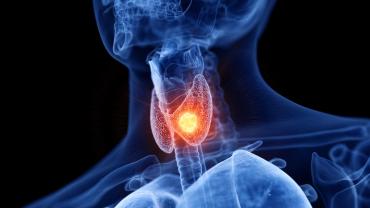
Hashimoto’s thyroiditis (HT) is an autoimmune condition that primarily affects the thyroid gland. HT is characterized by primary hypothyroidism – a condition where the thyroid does not produce enough thyroid hormones. Several factors, including genetic susceptibility, environmental triggers, and epigenetic modifications, contribute to the etiology of HT. Women are about four times as likely as men to be diagnosed with HT. Furthermore, individuals living in low- to middle-income areas are more likely to develop HT compared to those residing in upper-middle- or high-income areas, indicating that socioeconomic status affects HT prevalence.
Clinical indications of HT include low levels of thyroxine (T4) or triiodothyronine (T3), along with elevated thyroid-stimulating hormone (TSH) levels. Subclinical hypothyroidism is classified based on TSH values: levels between 4.5 and 9.9 mIU/L are considered Grade 1, while levels above 10 mIU/L are classified as Grade 2. This grading system helps assess the severity of the condition and supports clinical decision-making by health-care practitioners. Symptoms of HT may include:
Men may experience additional clinical indications of HT, including decreased testosterone concentrations, erectile dysfunction, and changes in sperm quality. The prevalence of HT has been increasing in the United States and globally. These factors, along with the increased risk of patients with HT to develop comorbidities like coronary heart disease, highlight the importance of novel treatment strategies to support this population.
A recent case study published in the journal Alternative Therapies in Health and Medicine examined the effect of a personalized nutritional and nutraceutical protocol on indicators of endocrine health in a male with HT. A 27-year-old male was diagnosed with HT in October 2020, identified through routine bloodwork. The bloodwork revealed elevations in antibodies against thyroglobulin and thyroid peroxidase (TPO Ab), as well as elevated TSH levels. A maternal family history of hypothyroidism and HT was reported, signifying a genetic predisposition. Prior to the personalized lifestyle-focused intervention, the patient became more mindful about his intake of fruits and vegetables and decreased intake of starchy foods including breads and pastas.
Lab work completed in July 2021 revealed normal T3 and T4 levels. However, serum vitamin D levels were deficient (25.98 ng/mL). Additionally, persistent elevations in TPO Ab (65 IU/mL) were reported four months later. Based on these findings, the treating endocrinologist and the patient agreed that dietary and lifestyle modifications should be pursued before considering pharmacologic intervention. After presenting to an integrative nutrition clinic in early 2023, TPO Ab levels were elevated (142 IU/mL), vitamin D insufficiency was found (28 ng/dL), and total (336 ng/dL) and free testosterone (38.3 pg/mL) levels were at the lower end of normal. The initial personalized intervention included incorporating an anti-inflammatory diet, along with 10,000 IU of vitamin D3 daily, in combination with daily K2 supplementation.
After incorporating these changes for several weeks, lab findings revealed persistent TPO Ab and TSH elevations (138 IU/mL and 12.10 uIU/mL, respectively). Considering these findings, a comprehensive stool analysis (CSA) was suggested to evaluate the potential gastrointestinal involvement in gluten sensitivity and autoimmune thyroid dysfunction. Results from the CSA indicated elevated anti-gliadin IgA, elevated secretory IgA, a high steatocrit, elevated Staphylococcus spp., and a reduced abundance of Akkermansia muciniphila. These findings are consistent with digestive insufficiency, altered gut mucosal barrier health, and an immune reaction to gluten at the level of the gastrointestinal (GI) tract. The patient’s intervention was adjusted to the following:
Dietary:
Supplemental:
Repeat bloodwork in November 2023 demonstrated slight improvements in TPO Ab and TSH, though both remained elevated. Total testosterone levels also decreased at this time, and the patient reports having difficulty gaining muscle mass, despite consistent strength training habits. When total (224 ng/dL) and free (7.5 pg/mL) testosterone levels were reported to be below normal ranges in August 2024, along with the patient’s subjective experience of suboptimal muscle mass development, a supplement that included 300 mg of trans-geranylgeraniol (GG) was suggested to the patient to be taken twice daily (for a total of 600 mg) over nine weeks.
By November 2024, follow-up laboratory evaluation demonstrated an increase in total testosterone, rising from 224 ng/dL to 413 ng/dL. From the patient’s perspective, “Once we tackled my low testosterone levels naturally, everything started to shift. My levels nearly doubled, and I noticed a big difference in the gym, especially in my strength and recovery.”
This case study highlights potential benefits of a personalized and integrative dietary, nutraceutical, and lifestyle protocol. While it provides promising insights, it reflects an individual’s response to a customized protocol. Therefore, these findings may not be generalizable. Additional research in diverse populations is needed to draw more firm conclusions.
Learn more about thyroid and men’s health:
The Hidden Connection Between Erectile Dysfunction and Antioxidant Status
The Thyroid-Gut Axis: Is There a Connection Between Thyroid Health and the Gut Microbiome?
Combination of Geranylgeraniol + Ubiquinol to Support Mitochondrial Function
Minerals to Promote Thyroid Health and Immune Function
By Bri Mesenbring, MS, CNS, LDN